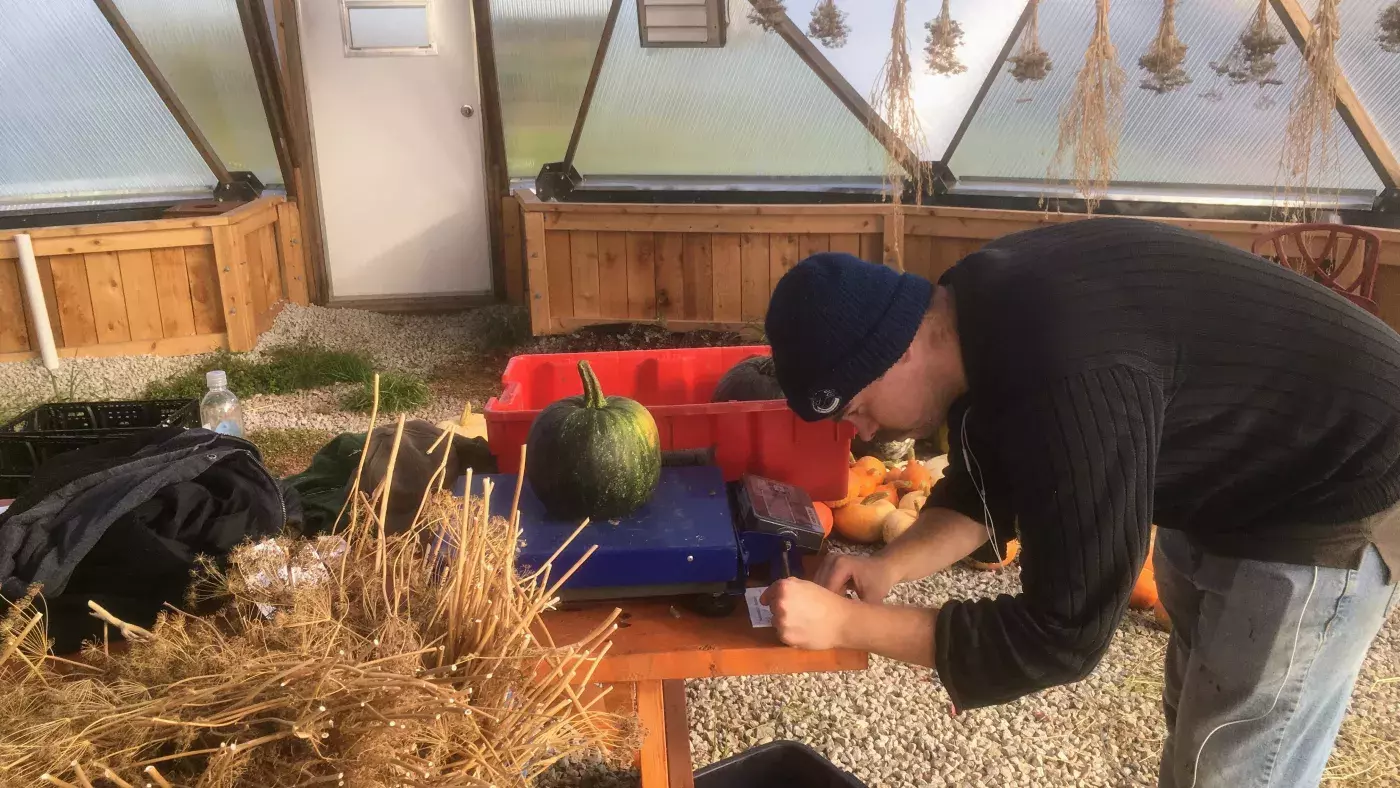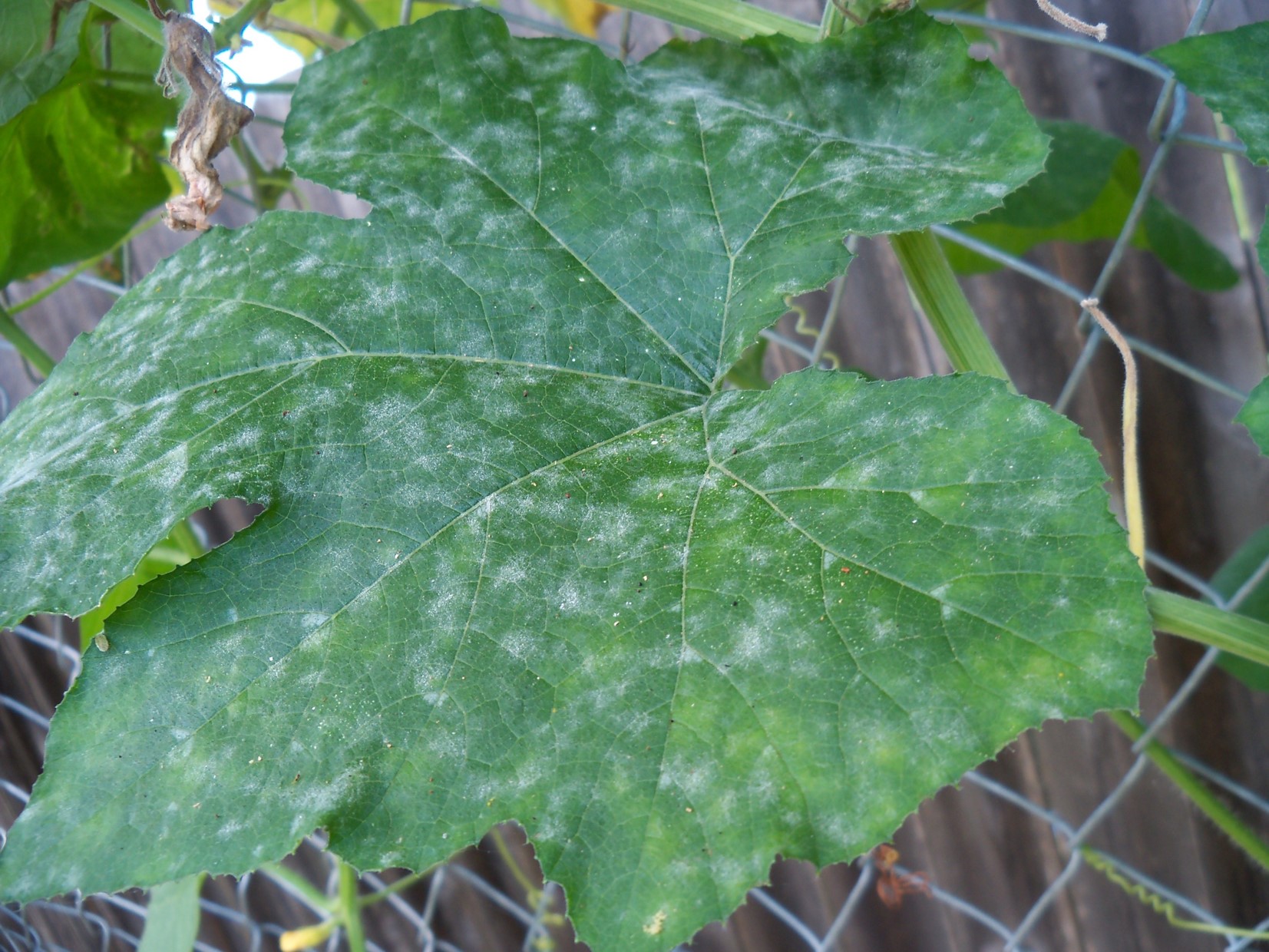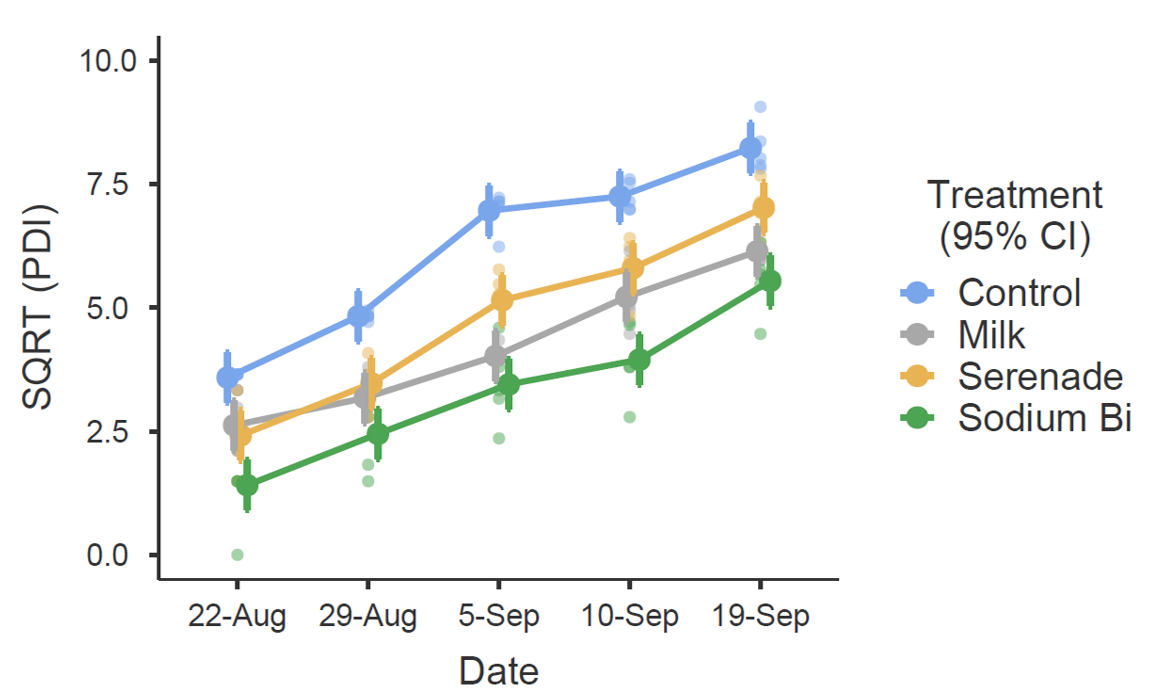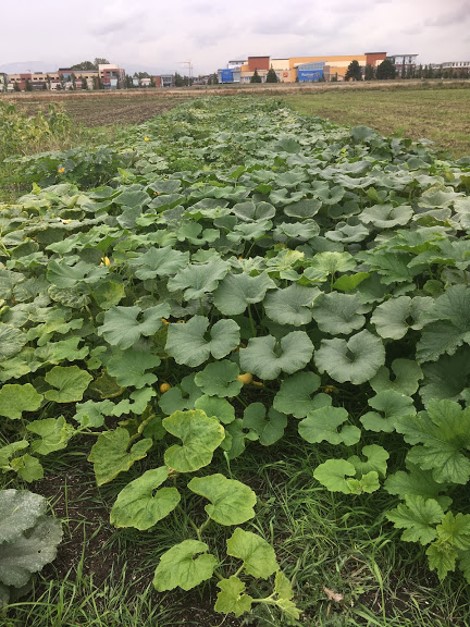

Sustainable Agriculture Student Research Project
Efficacy of fungicides available for powdery mildew control in certified organic squash productionJordan Roper, Department of Sustainable Agriculture and Food Systems, 2019 |
|
Introduction
Powdery Mildew (PM), caused by Sphaerotheca fuliginea, Podosphaera fuliginea and Erysiphe cichoracearum in cucurbits, is one of the largest challenges faced by growers throughout the world. With growing concerns over the environmental impact of conventional fungicides and the ability of PM species to quickly become resistant to them, the need for affordable, effective, and broadly applicable treatments is apparent. This study was designed to evaluate three such methods, their ability to control PM, and their potential impact on marketable yield. Strain 713 of Bacillus subtilis, cow’s milk, and sodium bicarbonate (NaHCO₃) have all demonstrated an ability to control the fungal infection (Bayer 2019, Bettiol 1999, Zaki et al 2011). This study compares these products directly.

Figure 1. Powdery mildew on cucurbit leaf
Objective
Compare efficacy of B. subtilis, cow’s milk, and sodium bicarbonate as fungicides to control powdery mildew in cucurbits and improve crop yield.
Methods
Experimental Design
- Study conducted at KPU Teaching and Research Farm, Garden City Lands, Richmond, B.C.
- Randomized complete block design with four treatments and five replicates
- Three varieties of winter squash per plot (Styrian seed pumpkin, Galeux D’eysine, and Red Kuri - Fig. 2)
- Two week-old squash plants transplanted 31 July and harvested 10 October
- Treatments applied weekly with hand sprayer (14 Aug – 19 Sept)

Figure 2. Styrian, Galeux d'Eysine, and Red Kuri squash
Treatments
- Serenade Opti (B. subtilis strain 713, 0.8 g per plant mixed with water) solution.
- Cow’s milk (25% milk w/ 2% MF, and 75% water) solution.
- Sodium bicarbonate (2% NaHCO₃, 98% water) solution.
- Control (Untreated and unsprayed)
Disease Progress Assessment
- Conducted before each spray application
- 3-6 leaves randomly selected from each plant (3 at early stages when plants were small)
- Infected area of each leaf rated on scale of 0-5
- 0 = no infection
- 1 = 0.1% to 10%
- 2 = 10.1% to 15%
- 3 = 15.1% to 25%
- 4 = 25.1% to 50%
- 5 = over 50%
- Percent Disease Index (PDI) = ΣR / 5n x 100% (Anand et al. 2009)
Where- R = individual disease ratings
- n = number of leaves rated
Statistical Analysis
- Mean PDI calculated for each plot on each sampling date
- Mean weight of each squash variety recorded for each plot after harvest
- PDI and yield data square root transformed to normalize distributions
- PDI analyzed by linear mixed model, with date and treatment as fixed effects and replicate as random effect
- Means separated by post-hoc test using Bonferroni correction
- Yield data subjected to ANOVA
Results
- PDI differed between each treatment (Table 1)
- Sodium bicarbonate was the most effective PM control, followed by cow’s milk, followed by Serenade Opti (Fig. 3, Table 1)
- All fungicides were more effective than the control (Fig. 3, Table 1)
- Squash yield did not differ between treatments
| Treatment | √PDI | S.E. | 95% C.I. |
|---|---|---|---|
| Note. Means are estimated by averaging across interacting variables. Means followed by the same letter do not differ significantly. | |||
| Control | 6.17a | 0.124 | 5.92-6.43 |
| Milk | 4.24c | 0.124 | 3.98-4.49 |
| Serenade Opti (B. subtilis) | 4.77b | 0.124 | 4.52-5.03 |
| Sodium bicarbonate | 3.36d | 0.124 | 3.10-3.62 |

Figure 3. Square root of Percent Disease Index by fungicide treatment over time (n = 5). Error bars denote 95% confidence interval.
Discussion
- All fungicidal treatments successfully reduced PM advancement, but this did not translate into higher squash yield.
- Possible explanations include:
- PM advance occurred late in the growing season
- Late transplanting, after first planting was destroyed by birds, resulted in a shortened growing season
- Most squash did not reach maturity, possibly compromising yield
- Leaf burn was observed in Sodium bicarbonate and Serenade Opti treatments, potentially reducing yield
- Future studies could be improved in various ways:
- Larger plots with tractor-pulled spray rigs to better mimic commercial field conditions
- Computer image analysis to rate disease incidence
- Wider selection of varieties
- Early morning or evening sprays to avoid leaf burn

Figure 4. Study site, September 25, 2019.
Conclusion
A solution of 2% baking soda is more effective at controlling powdery mildew than a 25% milk solution, which in turn is more effective than the commercial biofungicide Serenade Opti. All of the fungicides tested were more effective than the control, but none improved squash yield.
Acknowledgments
Thank you to Dr. Michael Bomford for his depth of knowledge and assistance in statistical analysis; to Andy Smith for his on site assistance at KPU’s Garden City Lands Teaching and Research Farm; and to Piper Kenney, Riley Daman-Willems, and James Reinert for their thistle removal efforts and other weed control.